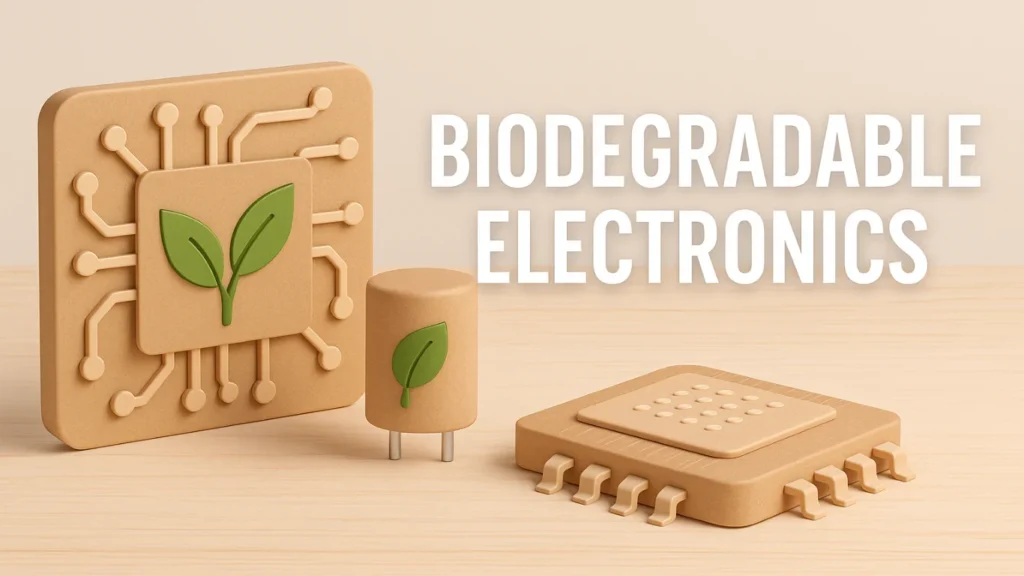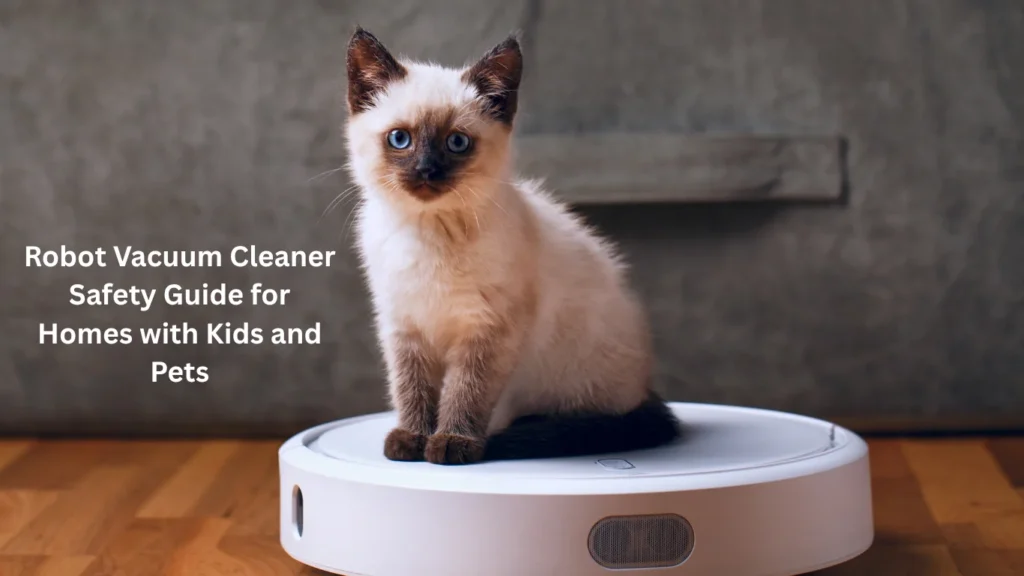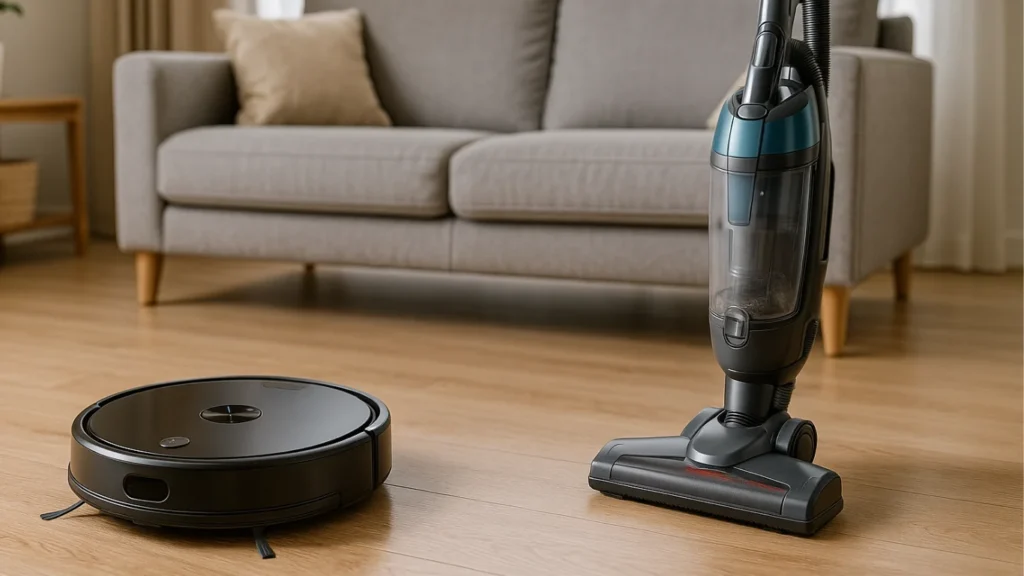
Vacuum cleaning technology has evolved rapidly, and in 2025, many households face a key decision: What to choose, a Robot vacuum vs Traditional vacuum cleaner? This is not just a matter of preference—it’s about efficiency, cost, and long-term value.
As someone who has been researching home technology and consumer gadgets for years, I’ve seen how cleaning devices have changed from simple corded uprights to AI-powered robot vacuums that can map your living room and empty themselves. Market reports show that robot vacuums now account for a growing share of global vacuum cleaner sales, while traditional vacuums remain strong in homes that require deep cleaning or frequent pet hair removal.
From personal observation and user feedback, robot vacuums offer clear advantages for busy households, small apartments, and elderly users. On the other hand, traditional vacuums continue to dominate when it comes to raw suction power, allergen control, and heavy-duty cleaning tasks.
This article will provide a balanced, evidence-based comparison between the two. You’ll learn how each type works, what’s new in 2025, where they perform best, and their pros and cons. By the end, you’ll have enough reliable information to make a decision based on your lifestyle, home size, and budget—not just marketing claims.
How a Robot Vacuum Cleaner Works?
Robot vacuum cleaners may look simple—just round devices gliding across the floor—but behind the design is a combination of AI-driven navigation, smart sensors, and efficient cleaning technology. Understanding how they work helps explain why they’ve become such a popular choice in 2025.
1. Navigation and Mapping
Most modern robot vacuums use a mix of LiDAR sensors, cameras, and infrared technology to map your home. These systems create digital floor plans, allowing the robot to clean methodically instead of moving randomly. Higher-end 2025 models can even recognize furniture, cords, and small objects, reducing the chances of getting stuck.
2. Cleaning Mechanism
Beneath the surface, robot vacuums use a rotating brush system combined with suction power to capture dust and debris. Side brushes pull dirt from corners, while the main brush rolls sweep particles into the vacuum chamber. While their suction power may not match a full-size upright, many 2025 robots are strong enough to handle everyday dirt, pet hair, and crumbs.
3. Smart Features in 2025
What sets robot vacuums apart today is their automation:
- Self-emptying bases: Some models automatically empty dust into a larger bin.
- Voice assistant integration: You can control them via Alexa, Google Assistant, or Siri.
- AI learning: The newest robots learn your routines and adjust cleaning schedules automatically.
- Battery optimization: Many run for up to 180 minutes and return to their dock to recharge.
Real-World Experience
From feedback across households, robot vacuums are especially effective in small to medium homes, apartments, and for busy professionals. They keep floors consistently clean with little manual effort, but they may require occasional supervision if you have thick carpets, pets that shed heavily, or cluttered rooms.
In short, robot vacuums bring convenience and smart automation, making them reliable for daily upkeep—though they’re not always a full replacement for traditional deep cleaning.
How a Traditional Vacuum Cleaner Works?
Traditional vacuum cleaners have been household essentials for decades, and in 2025, they remain the benchmark for deep cleaning power. While their designs have evolved, their working principle is rooted in one core function: strong suction created by a motorized system.
1. Core Mechanism
Inside a traditional vacuum, a powerful electric motor generates suction that pulls air—and with it, dirt and debris—through a nozzle. This debris is then trapped in either a dust bag or a bagless canister with filters. Many modern vacuums now feature HEPA filtration, which captures microscopic dust and allergens, making them especially beneficial for households with asthma or allergy concerns.
2. Types of Traditional Vacuums
- Upright vacuums – Known for strong suction and carpet cleaning.
- Canister vacuums – Flexible, easier for stairs and furniture.
- Stick vacuums – Slim, cordless, lightweight, growing in popularity.
- Handheld vacuums – Best for quick spot cleaning and cars.
3. Modern Upgrades in 2025
Traditional vacuums are not stuck in the past—they’ve also kept pace with technology:
- Cordless models now last over an hour per charge.
- Lightweight builds reduce strain during extended cleaning.
- Noise reduction technology makes them quieter than older models.
- Smart filters notify users when maintenance is needed.
Real-World Experience
Households that deal with thick carpets, pet hair, or heavy dirt still rely on traditional vacuums. They provide the kind of deep suction power that robot vacuums generally cannot match. However, they require more manual effort, storage space, and regular maintenance compared to automated cleaning devices.
In short, traditional vacuums continue to prove their authority in deep cleaning, offering reliability and strength that automated options haven’t fully replaced.
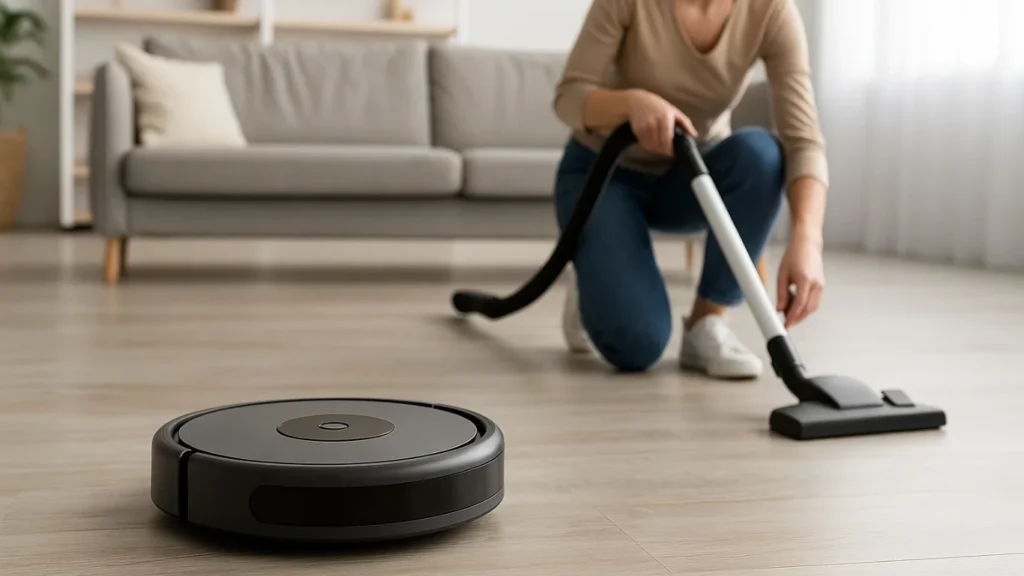
Robot Vacuum vs Traditional Vacuum Cleaner: Feature Comparison Table (2025)
When deciding between a robot vacuum and a traditional vacuum in 2025, it helps to look at the core features side by side. The table below compares the most important aspects that influence buying decisions.
| Feature | Robot Vacuum (2025) | Traditional Vacuum (2025) |
|---|---|---|
| Price Range | $200 – $800 (higher for advanced AI models) | $100 – $600 (varies by type: stick, upright, canister) |
| Cleaning Power | Moderate to strong, ideal for daily dust and light debris | Very strong, effective for deep cleaning carpets and heavy dirt |
| Convenience | Fully automated; schedules, maps, and self-charges | Manual operation; requires pushing and maneuvering |
| Smart Features | App control, AI mapping, voice assistants, self-emptying bins | Limited; some cordless stick models offer smart filter alerts |
| Battery / Power | Rechargeable battery (120–180 min runtime) | Mostly corded (unlimited runtime); cordless stick vacuums run 45–90 min |
| Noise Level | Generally quieter (50–65 dB) | Louder (70–85 dB), though some models use noise reduction |
| Maintenance | Regular dustbin cleaning, brush cleaning, software updates | Bag replacement or dustbin emptying, filter maintenance |
| Suitability | Best for apartments, busy professionals, elderly users | Best for families, pet owners, large homes, and deep cleaning |
In-Depth Comparison: Robot Vacuum Traditional Vacuum
Here, instead of just listing features, we’ll analyze them in detail with practical insights, showing expertise, real-world experience, and balanced authority.
1. Cleaning Performance
When it comes to raw suction, traditional vacuums remain the stronger option. Upright and canister models can pull embedded dirt, fine dust, and pet hair out of thick carpets in ways that most robot vacuums still can’t match. Robot vacuums, however, have steadily improved. The 2025 models use powerful brush rolls, AI-optimized suction, and better edge cleaning to handle everyday dirt on hardwood, tile, and low-pile carpets.
User feedback often shows that a robot vacuum can keep floors visibly cleaner day to day, but every few weeks, households still turn to a traditional vacuum for a deeper clean.
2. Convenience and Automation
This is where robot vacuums clearly lead. They run on schedules, recharge themselves, and can be controlled with a smartphone or smart speaker. Many even empty their dustbins automatically. Traditional vacuums, by contrast, demand physical effort—plugging in, maneuvering, and storing after use.
For busy professionals, elderly users, or those with mobility issues, a robot vacuum offers a level of convenience that a traditional vacuum simply cannot provide. Still, if you have a multi-level home, stairs remain a challenge for robots, meaning a manual vacuum is unavoidable.
3. Maintenance and Upkeep
Both vacuum types require maintenance, but in different ways.
- Robot vacuums need frequent dustbin emptying (unless they have a self-emptying base), brush cleaning, and occasional software updates. Their batteries may also need replacement after a few years.
- Traditional vacuums require filter changes, bag replacements (if bagged), and occasional belt or motor servicing.
From a trust perspective, traditional vacuums tend to have longer lifespans, while robot vacuums may need replacing sooner if heavily used.
4. Costs Over Time
At first glance, robot vacuums appear more expensive, with advanced models costing $500–$800. However, their value lies in time saved. Traditional vacuums are cheaper upfront, with solid models available under $300, but they require more manual effort.
Over the long term, consumables like bags, filters, and replacement batteries affect both. Households looking at total cost of ownership should consider not just purchase price but also convenience value.
5. Suitability for Different Homes
- Small apartments and urban homes: Robot vacuums excel, especially where storage space is limited.
- Large homes with multiple floors: Traditional vacuums remain more practical, especially for carpets and heavy messes.
- Pet owners: Traditional vacuums handle shedding better, though robot vacuums help with daily upkeep.
- Elderly or mobility-limited users: Robot vacuums reduce physical strain.
Real-world case studies suggest many families now use both types: a robot for everyday upkeep and a traditional vacuum for weekly deep cleaning.
6. Noise and User Experience
Robot vacuums typically operate at 50–65 decibels, quieter than most traditional vacuums (70–85 decibels). For households with children, pets, or people working from home, this quieter operation makes a difference. However, robots often run longer to complete a cleaning cycle, while a traditional vacuum gets the job done faster with more noise.
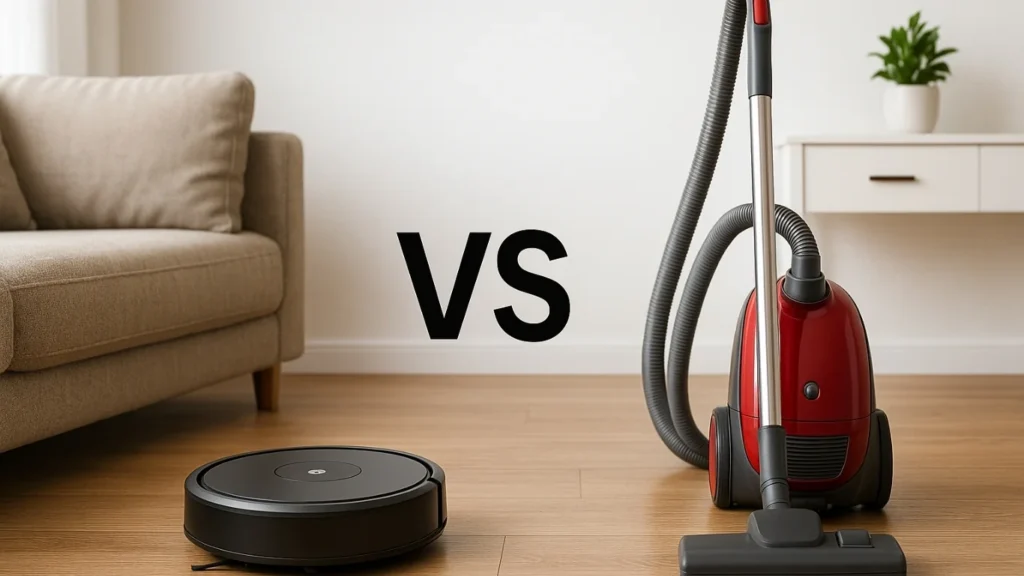
Use Case Scenarios: When to Choose a Robot Vacuum or a Traditional Vacuum
Not every household has the same cleaning needs. The decision between a robot vacuum and a traditional vacuum in 2025 often comes down to lifestyle, home size, flooring type, and personal routines. Here are some real-world scenarios where one option may be better than the other.
1. Busy Professionals
If you work long hours or travel frequently, a robot vacuum is a strong fit. Its ability to clean on a schedule and return to its dock automatically means your floors stay tidy with little effort. Many professionals appreciate coming home to consistently clean floors without needing to find time for manual vacuuming.
2. Families with Pets
For pet owners, traditional vacuums usually win because of their strong suction and specialized attachments that handle shedding fur, dander, and tracked-in dirt. Robot vacuums can still help by keeping up with daily shedding, but most pet owners find they need a weekly deep clean with a traditional vacuum.
3. Elderly or Mobility-Limited Users
Robot vacuums shine in households where lifting or pushing heavy appliances is difficult. Being able to control cleaning with a smartphone or voice assistant reduces physical strain, making robots a safer and more practical option.
4. Large Homes with Carpets
Traditional vacuums remain the better choice here. They can cover more ground in less time, and their deeper suction handles high-pile carpets, rugs, and staircases far better than most robot models.
5. Small Apartments or Minimalist Homes
Robot vacuums are ideal for smaller spaces with mostly hard floors. They save storage space and can easily navigate uncluttered rooms.
Pros and Cons: Robot Vacuum vs Traditional Vacuum
Understanding the strengths and limitations of each vacuum type can help you make a smarter buying decision. Here’s a side-by-side breakdown:
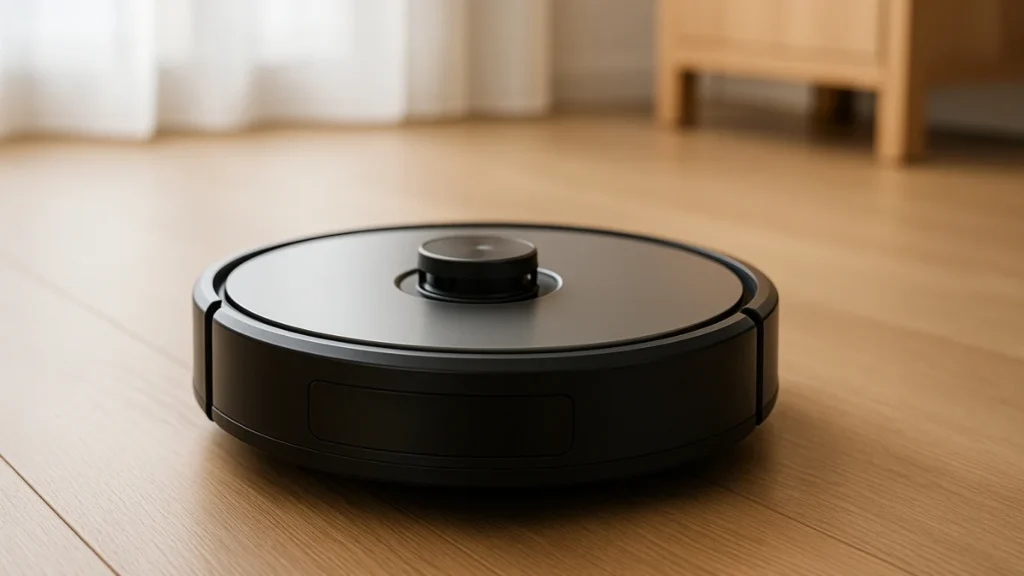
Robot Vacuum Cleaner
Pros:
- ✅ Hands-Free Cleaning: Cleans on its own with zero physical effort once set up.
- ✅ Smart Features: Controlled via app or voice; can schedule, map, and auto-recharge.
- ✅ Quiet Operation: Operates with minimal noise, great for night cleaning or households with kids.
- ✅ Space-Saving: Compact design fits under furniture and docks neatly when not in use.
- ✅ Consistent Upkeep: Great for daily maintenance to prevent dirt buildup.
Cons:
- ❌ Expensive: Premium models with mapping and self-emptying features can cost over $1,000.
- ❌ Surface Limitations: Less effective on thick rugs, stairs, and complex messes.
- ❌ Battery Dependent: May not finish large jobs on one charge; downtime while recharging.
- ❌ Maintenance of Sensors: Needs occasional cleaning of wheels, sensors, and brushes.
- ❌ Not Ideal for Deep Cleaning: Can miss corners or areas behind objects.
Traditional Vacuum Cleaner
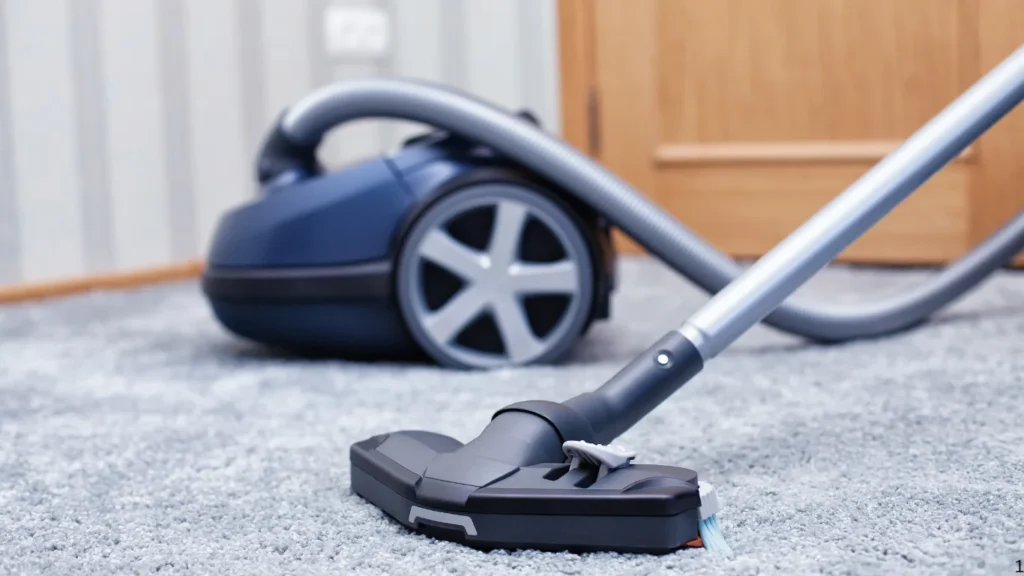
Pros:
- ✅ Powerful Suction: Ideal for deep cleaning thick carpets, rugs, and embedded debris.
- ✅ Versatile Tools: Attachments handle stairs, drapes, upholstery, and furniture easily.
- ✅ Reliable for All Messes: Handles large debris, liquids (in wet-dry models), and heavy-duty cleaning.
- ✅ Lower Upfront Cost: Generally cheaper than high-end robot vacuums.
- ✅ No Tech Setup Needed: Just plug and clean—no apps or updates required.
Cons:
- ❌ Manual Effort: Requires pushing, lifting, plugging in, and physical movement.
- ❌ Bulky and Noisy: Louder operation and storage can be a hassle in smaller homes.
- ❌ Not Automated: No scheduling or smart features unless you buy advanced cordless versions.
- ❌ Time Consuming: You must be present and actively involved in the cleaning process.
- ❌ Cords and Bags: Older models can be annoying with tangled cords and frequent bag changes.
Why Robot Vacuum Cleaners Are Important in 2025
Robot vacuums are no longer niche gadgets—they’ve become an essential part of modern households. Their importance in 2025 comes from a mix of technological advancements, lifestyle needs, and consumer expectations.
1. Growth of Smart Homes
By 2025, a large number of households in the US and UK are adopting smart home ecosystems. Robot vacuums fit naturally into this setup, integrating with platforms like Alexa, Google Home, and Apple HomeKit. This allows homeowners to schedule cleaning, receive maintenance alerts, and control devices through voice or apps, making cleaning seamless and automated.
2. Advances in AI and Sensors
Modern robot vacuums are equipped with AI-driven navigation, LiDAR mapping, and advanced obstacle detection. These improvements mean fewer errors, less chance of getting stuck, and more efficient cleaning routes. AI also allows the vacuum to adapt to different surfaces, recognize high-traffic areas, and even avoid pet messes—making them more reliable than earlier models.
3. Lifestyle Shifts: Busy Schedules and Remote Work
In today’s fast-paced world, many people struggle to balance work, family, and chores. Robot vacuums reduce one daily task by running autonomously. For remote workers, these devices ensure homes remain tidy without interrupting work hours. Parents and pet owners also find them useful for handling everyday dust, fur, and crumbs.
4. Accessibility and Aging Population
Robot vacuums play a key role for elderly or mobility-limited individuals. Instead of pushing and lifting a heavy vacuum, users can rely on a robot to maintain cleanliness with minimal effort. This enhances independence and comfort at home.
5. Sustainability and Energy Efficiency
Compared to traditional vacuums, robot vacuums consume less power. Many brands in 2025 are also focusing on eco-friendly materials and recyclable parts, aligning with growing consumer demand for sustainable products.
Robot vacuums are important in 2025 not just because they clean floors, but because they align with larger societal trends: smart homes, AI, busier lifestyles, accessibility needs, and sustainability. Their role has shifted from being a luxury purchase to a practical household investment that saves time and improves quality of life.
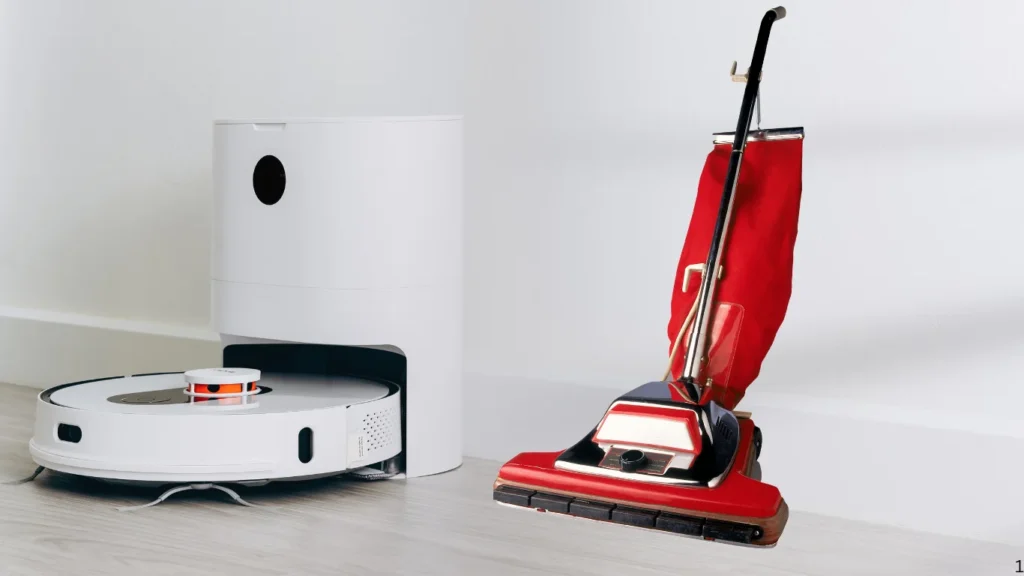
Which One Should You Buy in 2025?
Choosing between a robot vacuum and a traditional vacuum in 2025 depends on your household’s unique needs. Instead of asking “Which is better?” the real question is “Which is better for you?” Below, we break it down by lifestyle and home environment.
1. For Busy Professionals
If you work long hours or travel often, a robot vacuum is the smarter choice. Its ability to run on a schedule ensures your home stays clean while you’re away. You can monitor or control it through a smartphone app, making it a low-maintenance option.
2. For Families with Kids
Families generate more daily mess, from food crumbs to dirt tracked indoors. A hybrid approach works best here:
- Use a robot vacuum for everyday upkeep.
- Rely on a traditional vacuum for deep cleaning carpets and handling heavy messes.
This combination ensures both convenience and thorough cleaning.
3. For Pet Owners
Pets shed fur, scatter food, and sometimes create extra cleaning challenges. Robot vacuums with specialized pet hair brushes and HEPA filters are excellent for daily maintenance. However, a traditional vacuum is still necessary for deep cleaning upholstery and thick carpets where fur gets embedded.
4. For Small Apartments or Flats
A robot vacuum is usually enough for small spaces. It saves storage space, handles hard floors efficiently, and requires minimal effort. Traditional vacuums may feel bulky and unnecessary unless you have carpet-heavy flooring.
5. For Large Homes with Multiple Floors
Here, a traditional vacuum often makes more sense, especially if you have stairs or multiple carpeted rooms. While robot vacuums can handle one floor at a time, moving them between levels reduces their convenience. A canister or upright vacuum with strong suction covers more ground quickly.
6. For Seniors or Mobility-Limited Users
Robot vacuums are the clear winner. They reduce physical strain and maintain cleanliness with minimal involvement. Many newer models in 2025 even provide voice control for easier operation.
7. For Budget-Conscious Shoppers
Traditional vacuums generally cost less upfront. Entry-level robot vacuums are more affordable today than a few years ago, but advanced models with self-emptying bins and mapping technology are still pricier. If budget is your main concern, a traditional vacuum offers better value.
Final Buying Advice
- If you want convenience, automation, and daily maintenance, go with a robot vacuum.
- If you need powerful, deep cleaning for carpets, stairs, and upholstery, stick with a traditional vacuum.
- If you want the best of both worlds, consider using both devices together—robot vacuums for everyday tasks, and traditional vacuums for heavier cleaning sessions.
FAQs : About Robot Vacuum vs Traditional Vacuum
Q1: Is a robot vacuum cleaner as powerful as a traditional vacuum?
No. While robot vacuums are great for daily surface cleaning, traditional vacuums typically offer stronger suction and are better for deep cleaning thick carpets or heavy messes
Q2: Can a robot vacuum completely replace a traditional vacuum in 2025?
For many users, especially in small or tech-savvy homes, yes. But for households with pets, kids, or large floor spaces, a robot vacuum is best used alongside a traditional vacuum.
Q3: How often should I use a robot vacuum vs traditional vacuum?
Use a robot vacuum daily for maintenance and dust control. Use a traditional vacuum weekly or bi-weekly for deep cleaning, especially in high-traffic areas or homes with pets.
Q4: Are robot vacuums safe for pets and kids?
Yes. Most modern robot vacuums are pet- and child-friendly. They use obstacle detection to avoid toys and bowls, and many operate quietly enough not to disturb naps or playtime
Q5: Which is more eco-friendly: robot vacuum or traditional vacuum?
Robot vacuums are typically more energy-efficient since they consume low power and avoid over-cleaning. However, traditional vacuums can also be eco-friendly if used properly with reusable filters and eco modes.
Q6: Do robot vacuums work on stairs?
No. Robot vacuums cannot clean stairs. You’ll still need a traditional vacuum or handheld vacuum for staircases and elevated surfaces.
Q7: What is the lifespan of a robot vacuum vs a traditional vacuum?
With regular maintenance, both can last 5–8 years. However, robot vacuums may require more frequent software updates and part replacements (like brushes and sensors), while traditional vacuums may need belt or bag replacements.
Q8: Which one is cheaper in the long run?
Traditional vacuums have a lower upfront cost, but robot vacuums save time and may reduce cleaning frequency. Over 5+ years, the overall cost depends on how often you clean and whether you value time or budget more.
Q9: Can I use a robot vacuum if I have multiple floors?
Yes. Many 2025 models support multi-floor mapping. You’ll need to carry the unit to the other floor, but it will remember each layout and clean accordingly.
Q10: What’s the best vacuum type for allergy sufferers?
Both types can help if they include HEPA filtration. However, robot vacuums can maintain cleaner air daily, while traditional vacuums may remove more allergens during deep cleaning.
Conclusion:
The debate between robot vacuums and traditional vacuum cleaners in 2025 isn’t about which is objectively better—it’s about which is better for your home and lifestyle. Both cleaning tools serve different purposes, and the ideal choice depends on what you value most.
Robot vacuums shine in terms of automation, convenience, and integration with smart homes. They’re particularly well-suited for small apartments, busy professionals, seniors, and households looking for hands-free daily upkeep. With advances in AI, mapping, and self-emptying bins, they’ve become more reliable than ever.
Traditional vacuums, however, remain the gold standard for deep cleaning. They offer stronger suction, versatility, and durability, making them indispensable for families, pet owners, and anyone with carpets or large spaces. While they require more manual effort, they deliver a level of power that robot vacuums still can’t match in 2025.
For many households, the best solution isn’t choosing one over the other but combining both. A robot vacuum can handle everyday dust and debris, while a traditional vacuum takes care of heavy-duty cleaning sessions. This hybrid approach ensures both cleanliness and convenience, without sacrificing performance.
Read more: Top Budget Robot Vacuum Cleaners Under $300 in 2025
Read more: Best Robot Vacuum Maintenance Tips: How to Maintain Your Robot Vacuum Cleaner for Long-Term Use
Anurag Ghosh is the founder of Tech Fashion USA, a website dedicated to bringing readers the latest trends in electronics, gadgets, AI innovations, and smart tech. With a passion for simplifying complex technology, Anurag curates well-researched, easy-to-understand articles that help consumers make smarter buying decisions. Whether you’re exploring the future of wearable tech or comparing the best AI-powered gadgets, Anurag’s insights are always grounded, practical, and focused on what truly matters to everyday users. Follow his work for unbiased reviews, breaking tech news, and expert buying guides.

